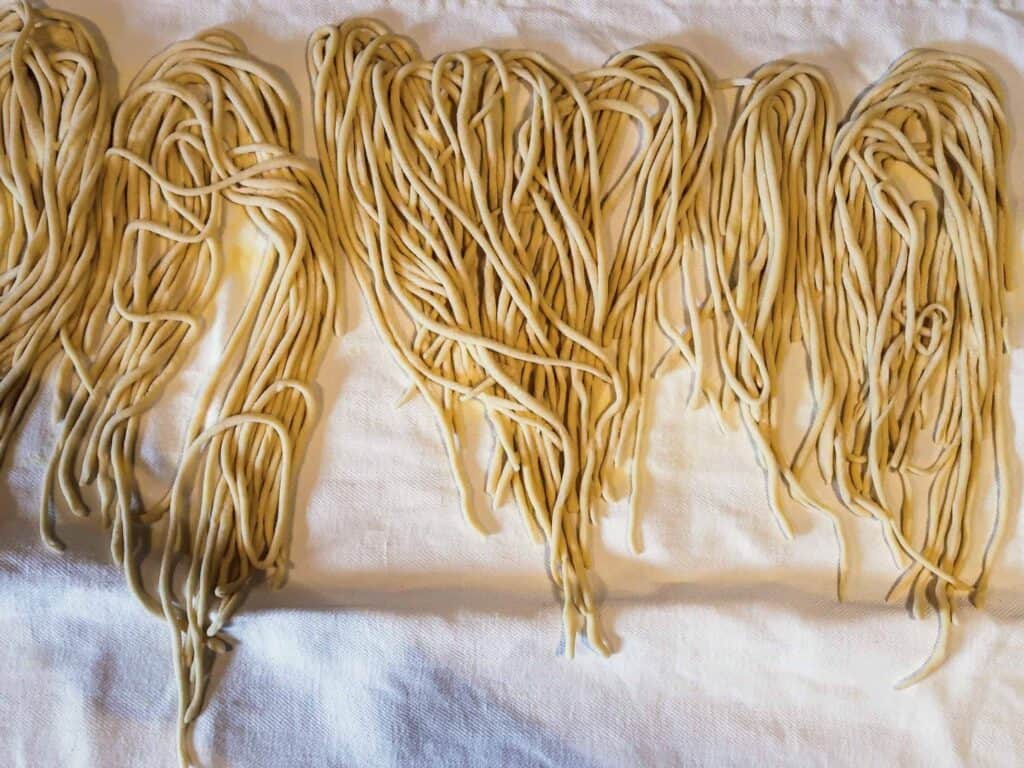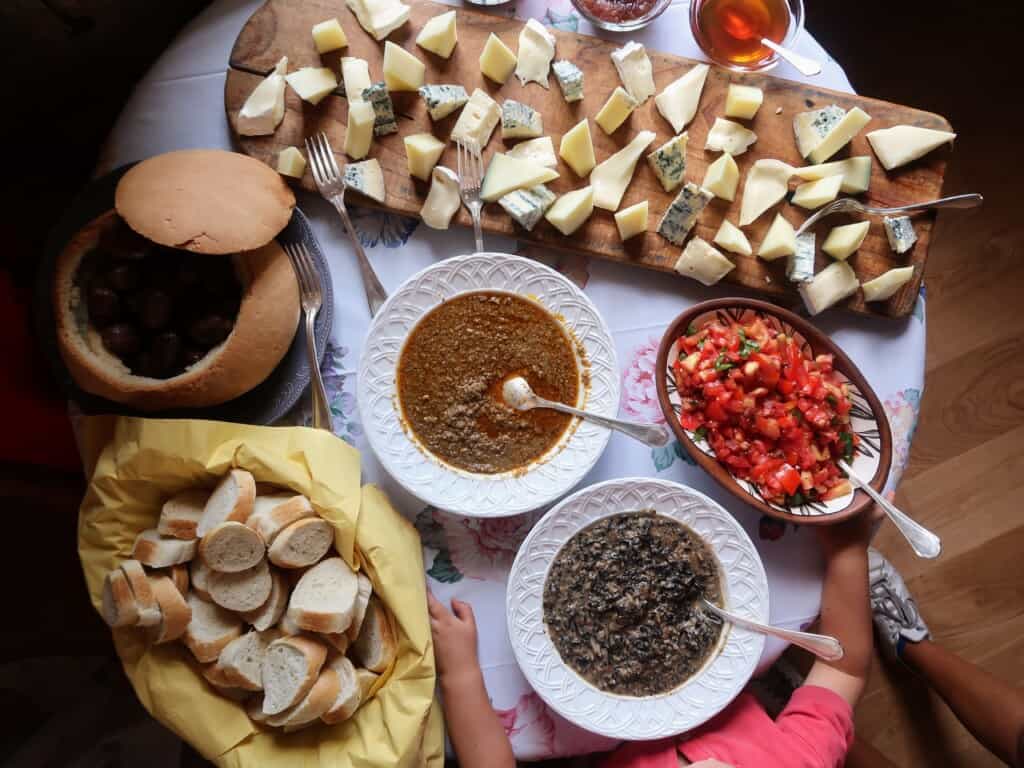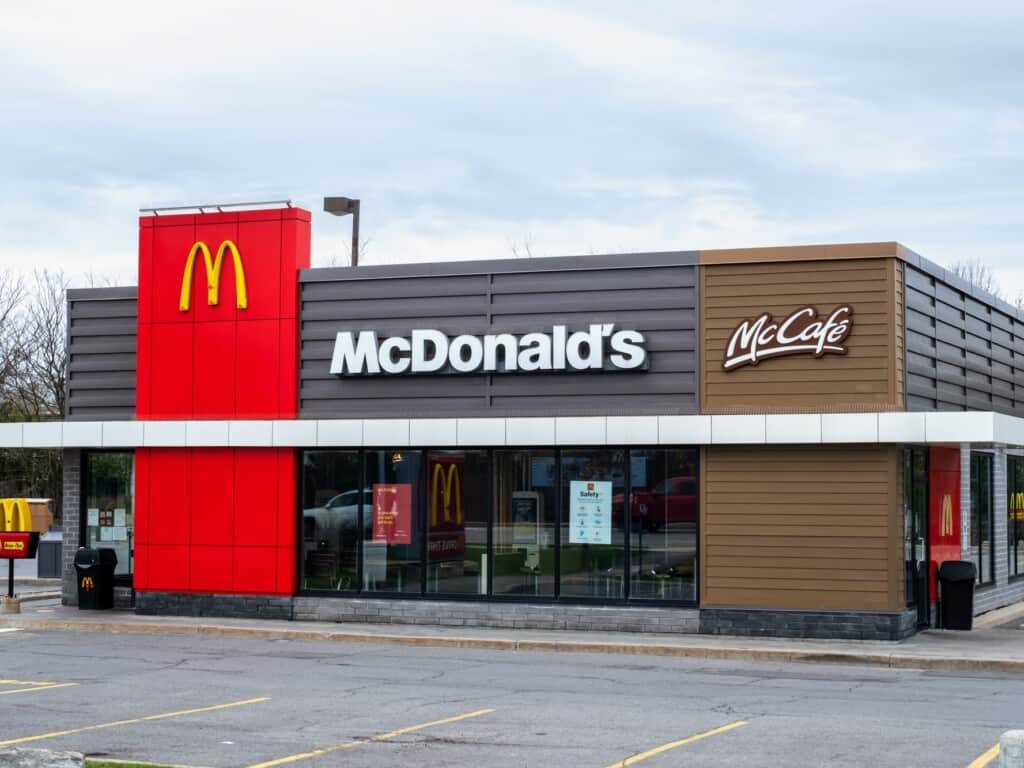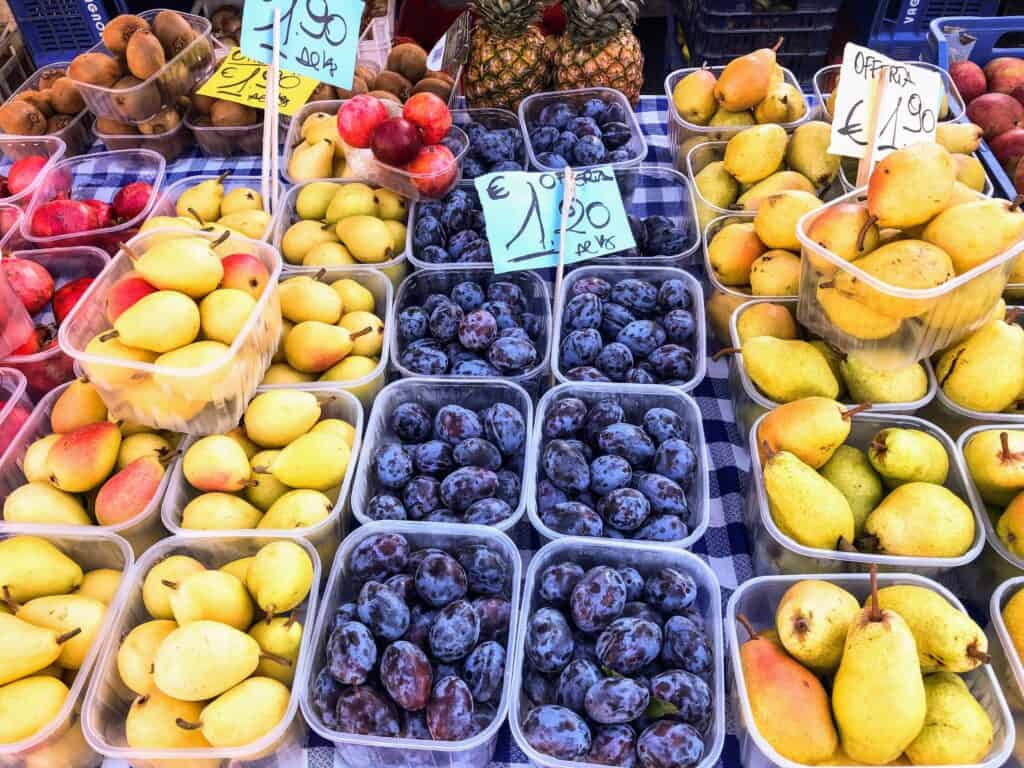Last updated on February 12th, 2024
Chances are you are planning on doing some grocery shopping while in Italy. And like most foreign experiences, the Italian grocery shopping experience differs from grocery shopping back at home.
In Italy, sometimes it just makes sense to shop at a grocery store instead of open air markets or other independent shops. Italian grocery stores have almost everything you need, conveniently in one spot.
Whether you are just looking to pick up a bit of produce for a picnic on a Sicilian beach, you need some milk for your coffee, or you’re planning for a week of food at your Tuscan villa, you will need to learn some Italian supermarket basics.
Italian grocery stores can be a wild experience if you haven’t prepared yourself for the fair amount of differences that you will come across when shopping.
In this guide, I will go over:
- various grocery store names in Italy
- what Italian supermarkets are best for
- the most important things to know before shopping at a grocery store in Italy
- how to make it to the end of your shopping list without having a meltdown
- important vocabulary to help you along the way.
It seems overwhelming but if you keep this guide handy, you will have your Italian grocery shopping done in no time!
Jump to Section
How To Pronounce Grocery Store In Italian

Grocery store in Italian is supermercato, pronounced soo-pehr-mehr-kah-toh in Italian.
Listen to the pronunciation of supermercato here:
If you are on the hunt for one close by, you can ask
C’è un supermercato in zona?
Is there a supermarket close by?
Types Of Grocery Stores In Italy
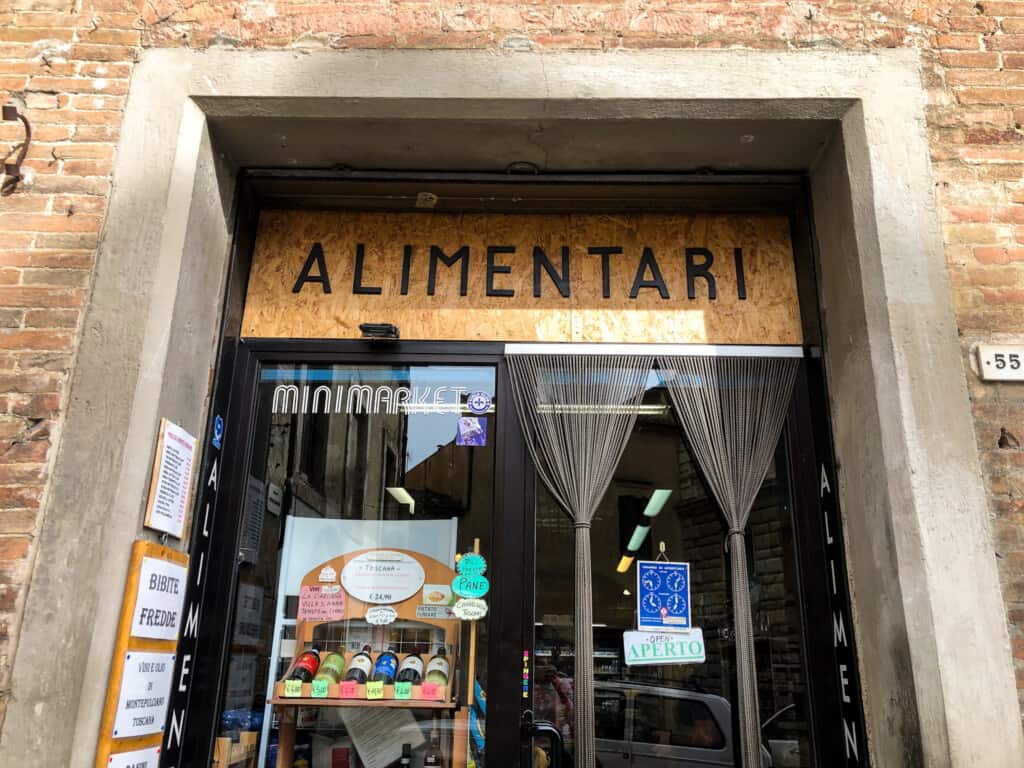
Grocery stores in Italy can be categorized by their size, which will in turn, affect what they offer and how much selection and variety you will find.
- ipermercati (hypermarkets)
- supermercati (supermarkets)
- convenience mercati (smaller supermarkets in city centers)
- discount (discount chains)
- alimentari (small, family-run grocers)
- gourmet (gourmet or specialized grocery stores)
- health food grocery stores
Good To Know: Open air markets, known as mercati in Italian, are not grocery stores. They are either indoor or outdoor markets with individual vendors selling various products such as produce, dairy products, household goods, honey, southern specialties, etc. Read more about Food Markets in Italy, How to Shop at Markets in Italy, and 10 Rules for Shopping at Markets in Italy.
Ipermercati (Italian Hypermarkets)
These chains are enormous grocery stores outside the city centers that stock many other things besides food including office supplies, toys, clothing, extended home goods, beauty products and even some basic furniture and garden tools and supplies.
They have better prices than at regular grocery stores and a much larger selection. Most of these are accessible by bus but I don’t recommend making the trek to one unless you are staying in Italy for an extended period. The price difference isn’t that substantial and they are usually not conveniently located.
Popular hypermarkets in Italy:
- Auchan
- Bennet
- Carrefour
- Coop
- Conad
- Decò
- Despar
- Panorama
- Sisa
Supermercati (Italian Supermarkets)

Supermercati are the normal, everyday grocery stores in Italy. They are a modest size – not tiny but not overwhelmingly large (think a step down from a Stop & Shop or Albertsons). You will find them throughout Italy in cities, smaller towns and dotted throughout the countryside. They have a wide selection of everything you need, making them the most popular option for Italians.
Popular supermarkets in Italy:
- Carrefour
- Conad
- Coop
- Crai
- Despar
- Esselunga
- Pam
- Sigma
- Sisa
Convenience Mercati (Smaller Supermarkets in Italian Town Centers)
These convenience mercati are smaller versions of the large grocery chains such as Conad or Pam often located in densely packed areas in city centers.
Also called mini-markets, these are well stocked to supply both local residents and tourists with the basics. The price point of these markets is usually slightly higher than normal grocery stores of larger size.
Convenience mercati in Italy:
- Conad City
- Punto Simply
- Carrefour Express
- Despar
- Eurospar
- Poli
- Metà
- Crai
Discount (Discount Supermarkets)

Discount supermarkets doesn’t mean the food is necessarily poor quality but the selection is limited and there is less commitment to Italian food products and companies. This being said, you can get a ton of the most popular items at these stores for a discounted price.
The biggest discount chains in Italy are:
- Eurospin
- MD
- Lidl
- Tuodì
- Penny Market
- In’s Mercato
- DPiù
Alimentari (Grocers)

An alimentare is the Italian equivalent of a small mom and pop grocer. They are usually pretty well stocked with the basics and tend towards local traditions and regional specialties. Places like this usually have pretty good foods to bring home as souvenirs.
Gourmet Grocery Stores In Italy
Eataly

About the size of a supermercato or slightly smaller depending on the location, Eataly is Italy’s gourmet chain supermarket, which also has branches abroad. They are committed to selling slow food products, ‘Made In Italy’ food, DOP, DOC and PGI quality stamps of approval.
It’s a great place to get and food gifts for cooks or stop in for lunch. They have various specialized restaurants within the supermarket, allowing each person to order what they want and then sit all together.
The prices are much higher but the quality is the best you can get in Italy.
Sapori E Dintorni Conad

Sapori E Dintorni is Conad’s gourmet branch, stocking higher quality and gourmet items. The price point is generally a little higher but you will also find a wide range of specialized DOP, IGP and DOC food items and wine.
Health Food Grocery Stores
Natura Sì
Natura Sì is Italy’s attempt at a Whole Foods (don’t be fooled, it’s nothing close to it though). The products they stock are local, organic and health forward. You can find tons of dairy substitutions, meat alternatives, vegan options and gluten-free choices. Each location will stock different items based on the regional produce and specialties but you will notice the basics are always the same.
Come here if you are looking for a wide selection of organic products, including toiletries, household products and anything baby related, including natural diapers and baby food.
Nice To Know: Natura Sì tends to also have a wider international section, especially when it comes to Asian ingredients such as soybean paste, tofu and condiments.
Other Food Shops In Italy
Specialty Shops

The old school way of shopping – going from one small store to the next – is still how many Italians shop because the quality is so much higher than at a grocery store.
It’s true that not everyone has time to hit up 5 different food stores to get everything that they need but most Italians can agree that buying bread and meat at specialty shops and supplementing the rest of their shipping at large grocery stores is the best balance between quality and reality.
I highly suggest doing the same and getting at least your meat and bread at specialty shops. If you are in search of some fruit for a snack, head to your nearest fruttivendolo for the best quality.

List of specialty food shops in Italy:
- macelleria (butcher)
- forno/panificio (bakery)
- fruttivendolo or ortolano (fruit & vegetable shop)
- pasticceria (pastry shop)
- pescheria (fish shop)
- enoteca (wine shop)
- pizzicheria (deli)
- caseificio or negozio di formaggio (where cheese is produced but often sold as well/cheese shop)

Mercati (Open-Air Food Markets)
Open-air food markets are where you are going to find the absolute best season and local produce and handmade food products in Italy. Either indoors or outdoors, mercati are made up of various vendors selling specific products such as cheese, produce, olive oil, dairy, etc.
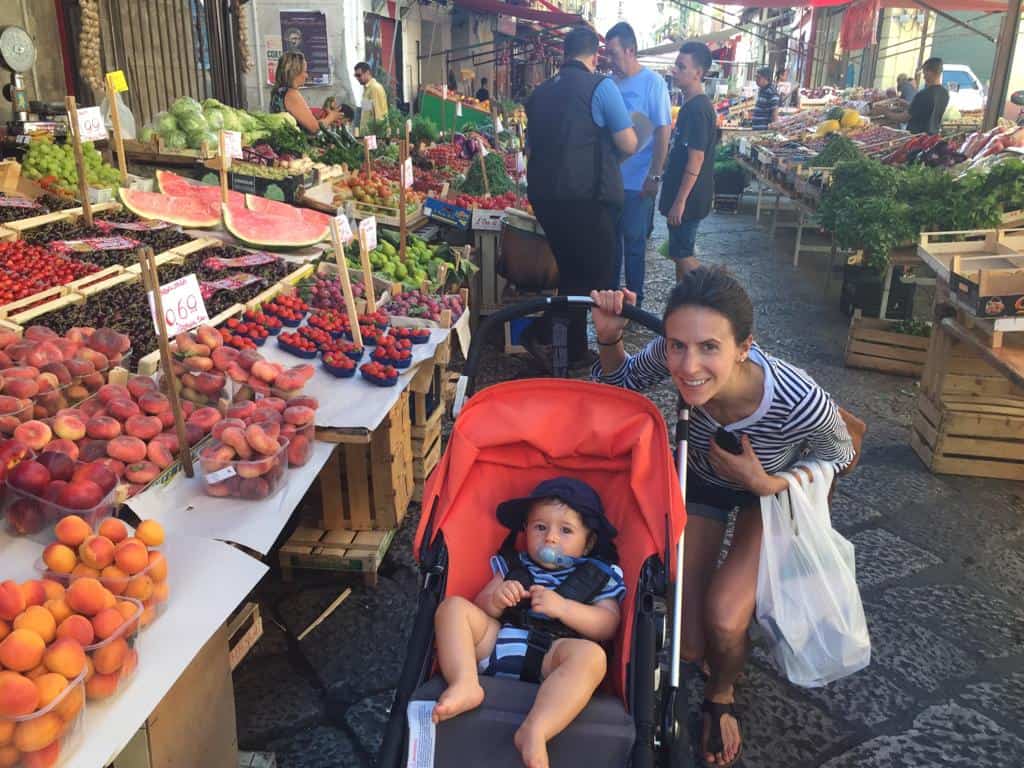
Ask a local or your hotel where the best market is and what day it is. I recommend just walking through one of these on your next trip to Italy because they really embody the life and soul of Italian food.
Nice To Know: Not all vendors are the same everyday at Italian open-air markets. Everyday and every market is a different experience in Italy.
Main Sections of an Italian Supermarket

Italian grocery stores are divided into aisles, just as overseas. Each aisle has sections, oftentimes listed overhead or on the end cap of each aisle.
In most supermarkets, food will be grouped in the following areas (but not always):
Fresh Produce – fresh, in-season fruits and vegetables

Forno – Bakery with freshly baked bread, pizza by the slice and pastries

Gastronomia – deli with cheeses, cured meats, prepared foods to be ordered by weight.
Refrigerated Section – milk, yogurt, packaged cheeses and cold cuts, fresh pasta
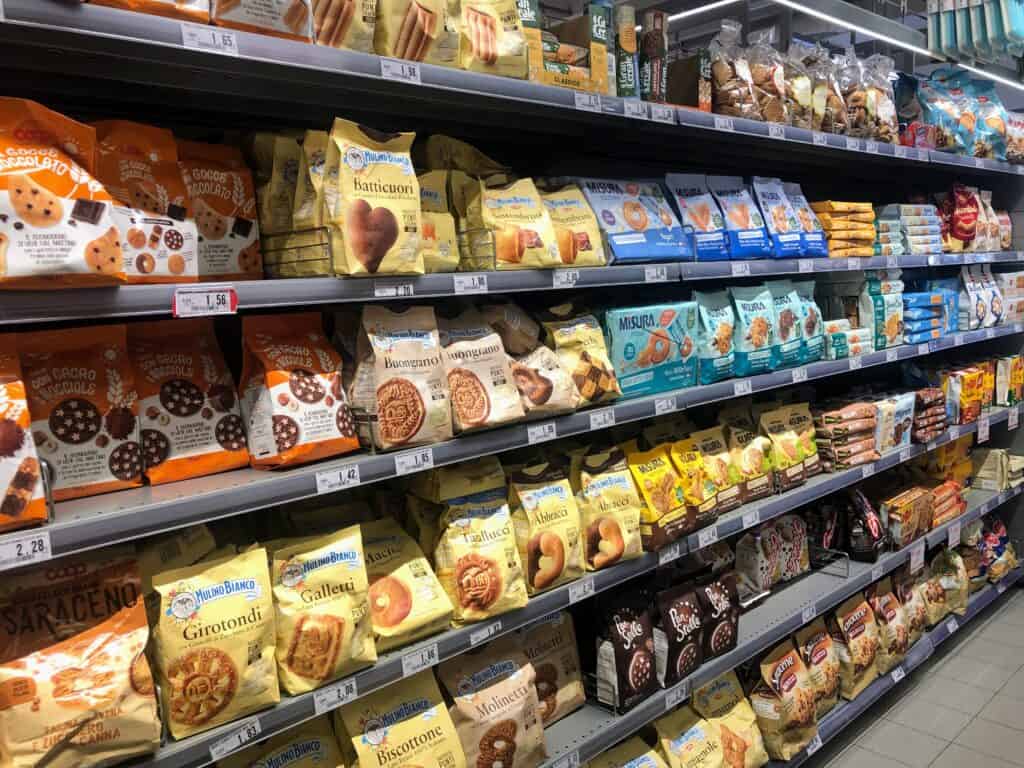
Colazione – breakfast with packaged Italian breakfast items such as prepackaged simple cookies, pastries, cereal, and granola bars.
Snacks – packaged savory items such as crackers, pre-packed sliced bread, breadsticks, etc. Chips and other junk food will be close by. Sweet cookies with chocolate or creams will be in another aisle all together.
Learn More: Read my guide to The Best Snacks You Can Buy at a Grocery Store in Italy.

Pescheria – fresh fish

Macelleria – butcher where you can either get pre-weighed items or ask directly at the counter for specific cuts and amounts of meat. At the counter, they will also cut it as you wish (slices, cubed, ground, etc).
Conserve – canned goods such as tomatoes, tuna and other fish, olives and preserved vegetables and beans.
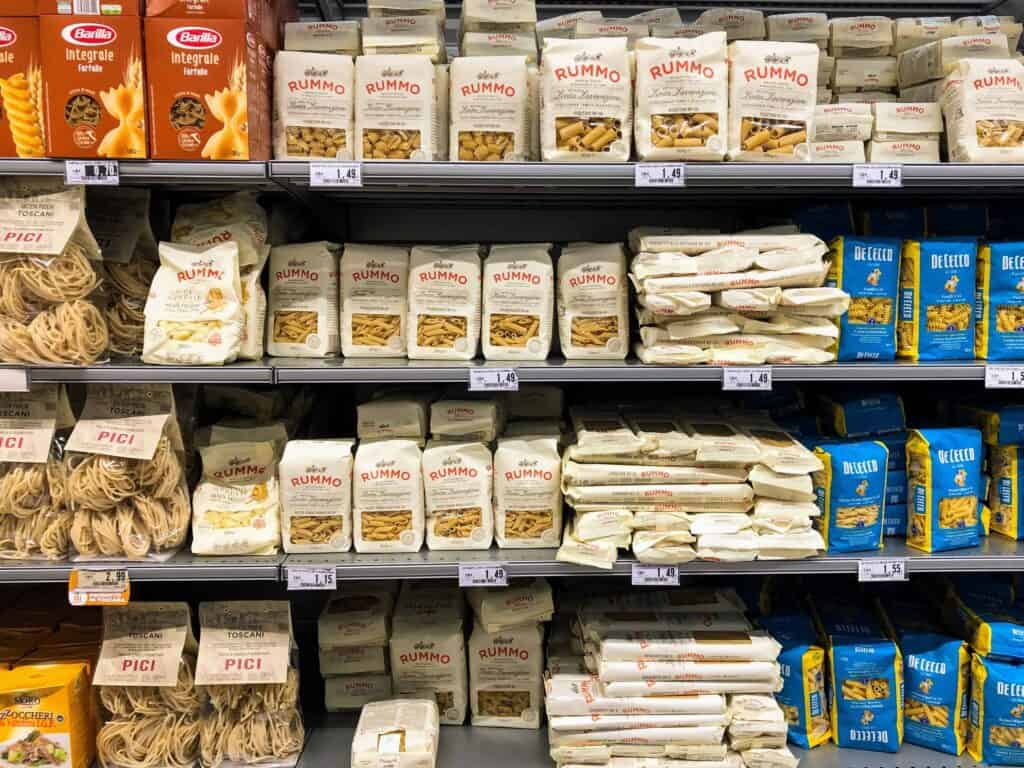
Dried Goods – pasta and rice will usually be together, sometimes taking up multiple aisles.
Baking Goods – typically close to the dried goods, including flour, leavening agents, cocoa powder, powdered sugar, gelatine, etc.

International Goods: Usually pretty limited and expensive.
Legumes: legumes, nuts, dried fruit and other grains such as quinoa, barley, farro, etc.

Senza Glutine: gluten-free sections are usually in larger supermarkets, selling pasta, packaged bread, crackers, cookies. Schär is the largest gluten-free company in Italy.
Bio: organic ‘health food’ section with non-dairy and vegan items. (this section is not in all supermarkets but rather, the food is scattered in with similar items in multiple aisles).
Beverages & Soft Drinks: large selection of soda, alcohol alternatives and juices. Sometimes the juice will be in another section. Aperitivo snacks will also be located in a small section here.
Acqua – Sometimes next to the beverages and other times in another section, this is where you will find all the water you need.

Cura di casa – household items such as toilet paper, paper towels, cleaning supplies, detergents, etc.
Toiletries – shampoo, conditioner, soap, dental care, deodorant, feminine supplies, bandaids, kleenex, etc.
Baby products – baby food, diapers, creams, baby wipes, formula, pacifiers, bibs, etc.
Prodotto per animali – products for animals such as toys, brushes and food.
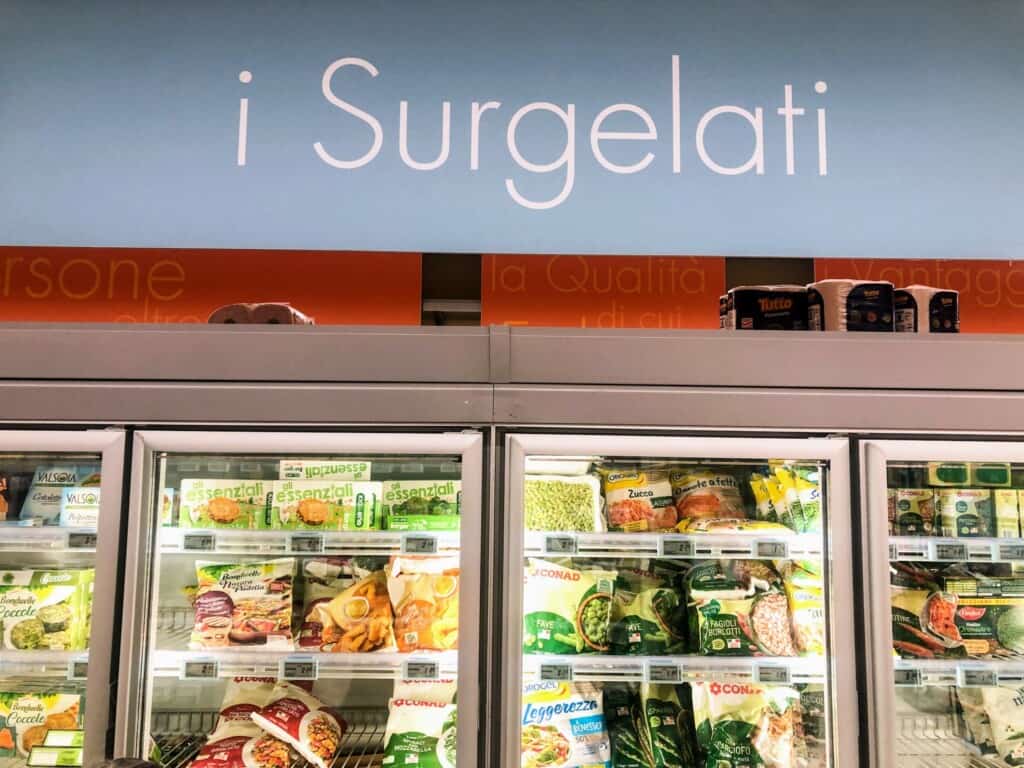
I Surgelati – frozen foods such as vegetables, meals, desserts, and of course, pizza!
Alcohol – wine, beer, bitters, liquors, etc.
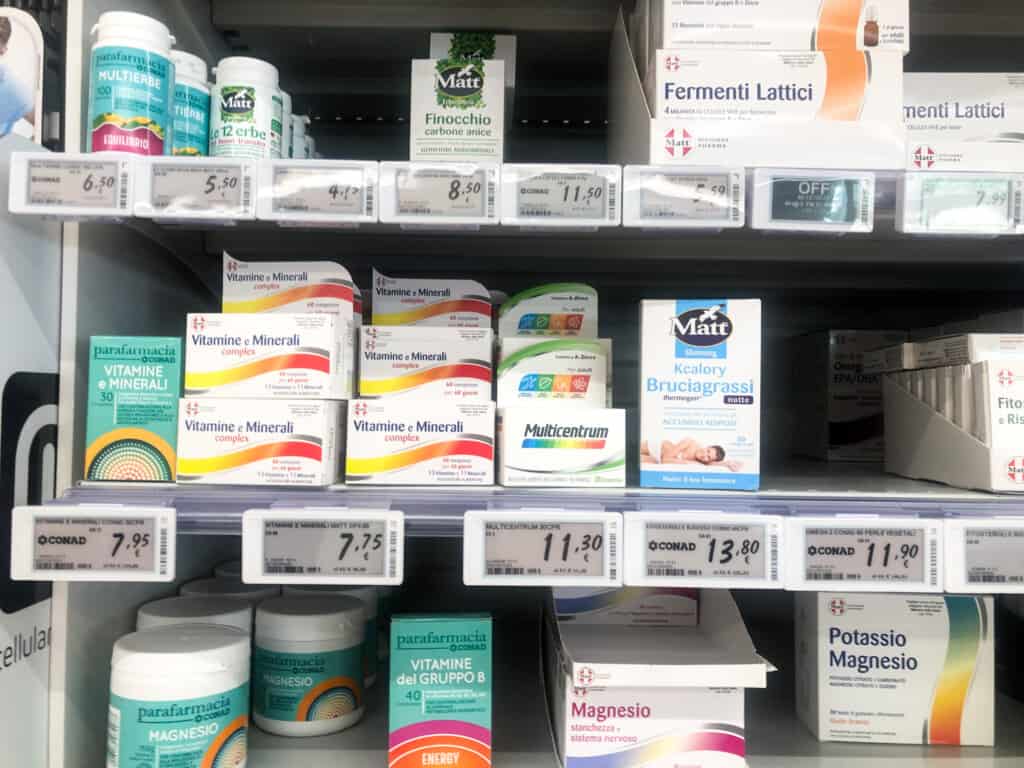
Good To Know: Grocery stores do not have real pharmacies in them but many have a small section with products without medications in them such as creams, ointments, vitamins, supplements, cough drops, etc.
Popular Foods In Strange Locations In Italian Grocery Stores
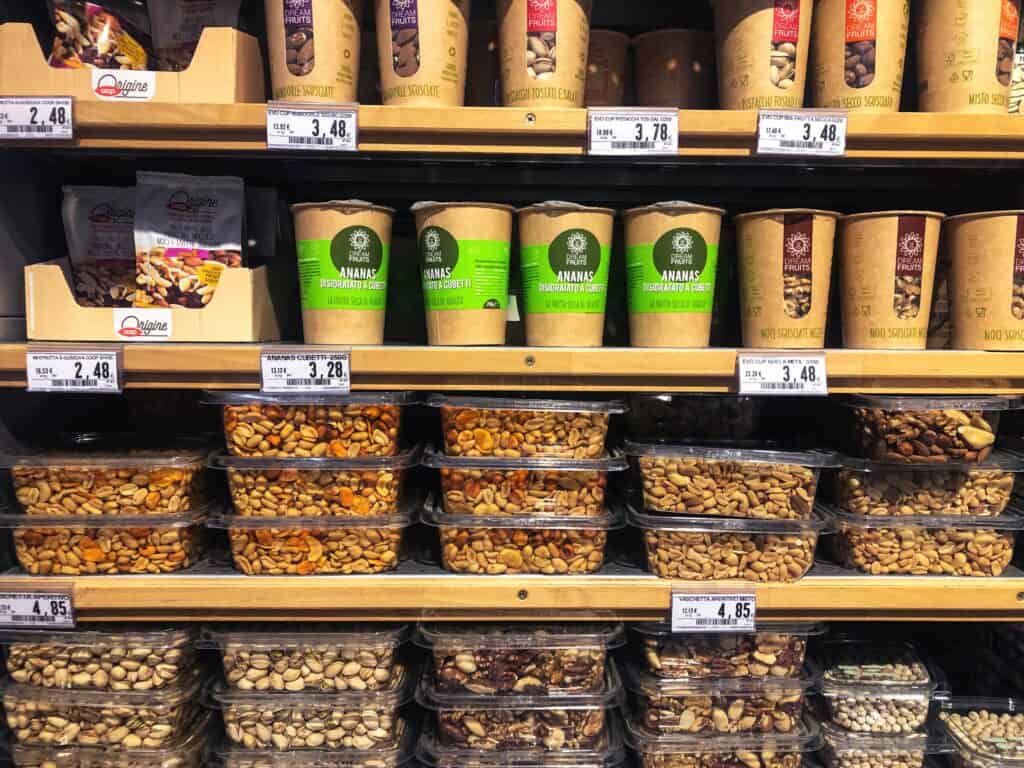
If you are looking for any of the following, they may not be where you think.
| English Food | Italian Translation | Location In Italian Grocery Store |
| Cookies | i biscotti | basic Italian shortbread cookies found in the breakfast aisle but fancy or chocolate covered cookies will be in another unknown location (depends on store) |
| Granola bars | le barrette | with the cereal and breakfast items or with the legumes next to the produce section |
| Nuts | le noccioline | Either with the legumes next to the produce section or in a small section in the soft drinks/beverage aisle (this is because they are lumped with other aperitivo items) |
| Eggs | le uova | In the first non-refrigerated aisle over from the refrigerated aisle. |
| Sugar | lo zucchero | Not always in the same spot: sometimes with baking items, sometimes with coffee and tea. |
| Milk | il latte | Next to the eggs in the first non-refrigerated aisle over from the refrigerated aisle. |
| Peanut Butter | il burro di arachidi | Either with the jams or in another section with the chocolate spreads and honey |
| Snacks | gli snack / merende | Snacks are located in various locations. Pre-packed sweet snacks are with the breakfast items, chocolate cookies such as wafer and usually in a different section from the breakfast cookies and crackers will be in another aisle all together! |
| Aperitif snacks | aperitivo | such as cocktail nuts, pretzels, small crackers will be grouped together in a small aperitivo section next to the the beverages |
| Apple sauce | polpa di mela (di frutta) | pureed fruit sauces come in small individual containers located in the produce section or next to the legumes and nuts. |
| Baking soda | bicarbonato | In a small section next to the soft drinks and beverages |
| Spices | le spezie | Sometimes spices will be on their own display wrack or located in the meat section. |
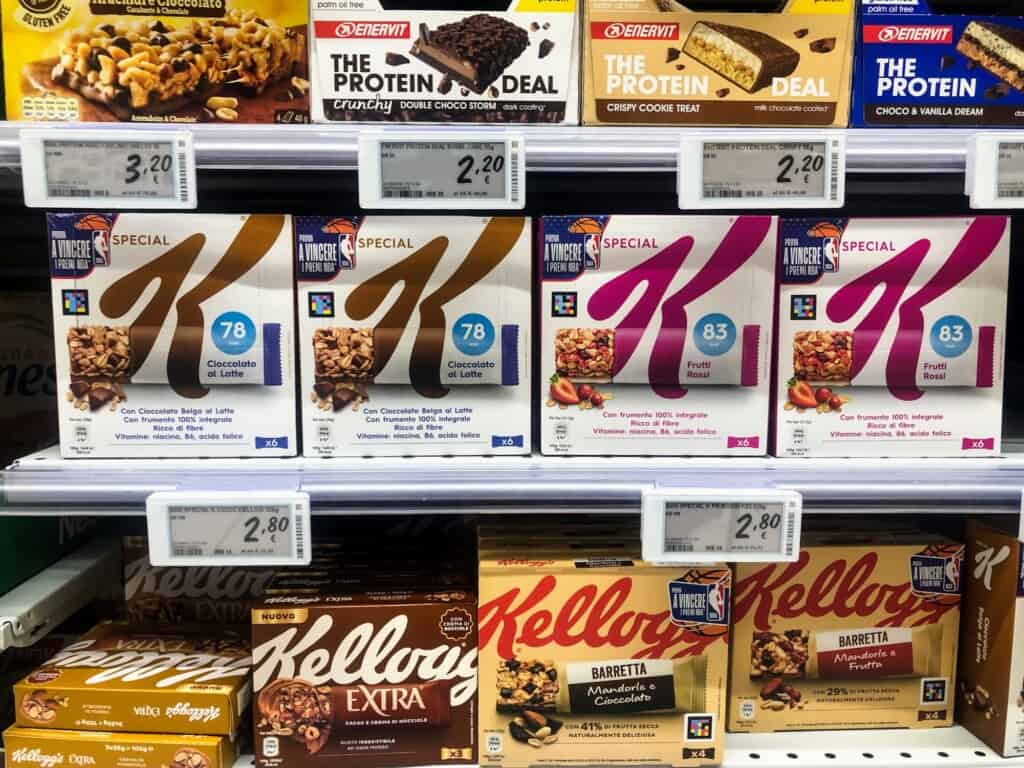
Differences In Italian Grocery Stores
Grocery Carts Are Not Free

To use a cart when grocery shopping in Italy you must put either a €0.50, €1 or €2 coin into the cart slot to release it from the other carts.
This may seem silly but it’s a way to ensure shoppers return their carts to the designated area. Once you link the cart to the one in front of it with a small chain, you get your money back.

Tip: If you find yourself without a coin head to the service desk and they will likely be able to give you a small plastic chip to use.
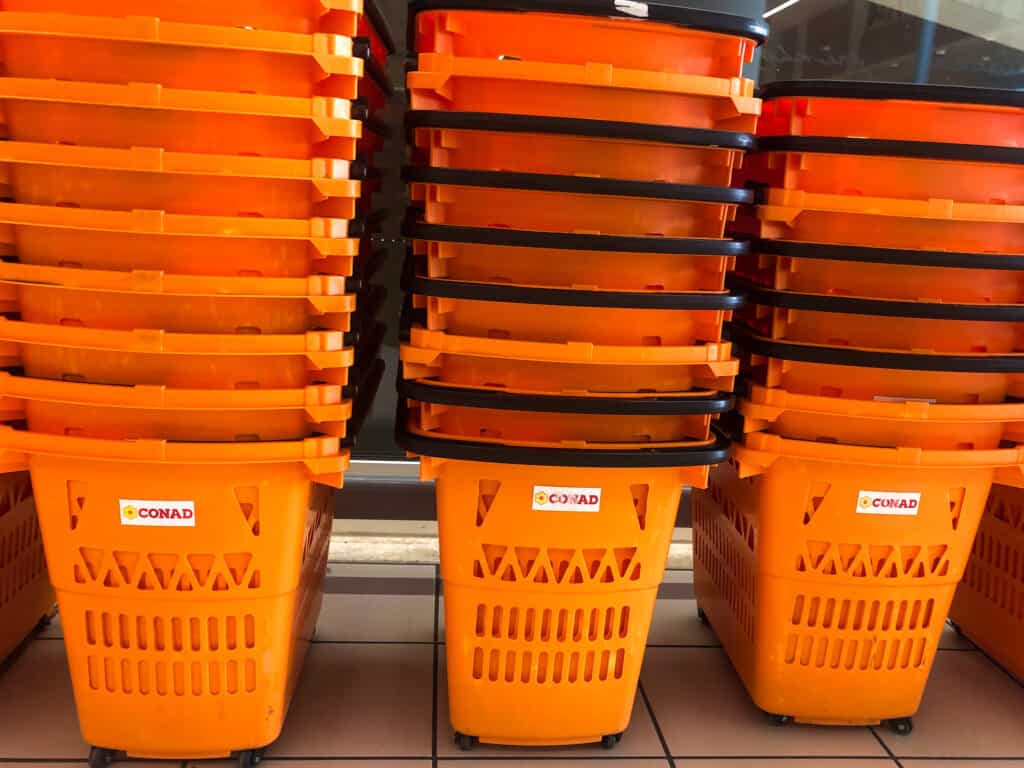
If you are only purchasing a few items, grab a small rolling basket located inside the store at the entrance, which has no need for a coin. You cannot bring these outside the store though!
Use a Glove To Choose Produce

Italians are big on hygiene so you need to use a small plastic glove to choose your produce. Look for a dispenser with gloves and plastic bags to put the produce in.
Fact: Not all produce needs to be weighed. Some are already weighed and will be wrapped and have a barcode on them (much of the organic produce is sold like this or things like avocados or plastic packages of fruit like strawberries that are sold individually, not by weight).
Once you have chosen your procure, you need to weigh it (see below).
Fact: Each small plastic bag for produce costs one cent. This is standard but you can choose to not use one for items like bananas or melons.
Weigh Your Produce
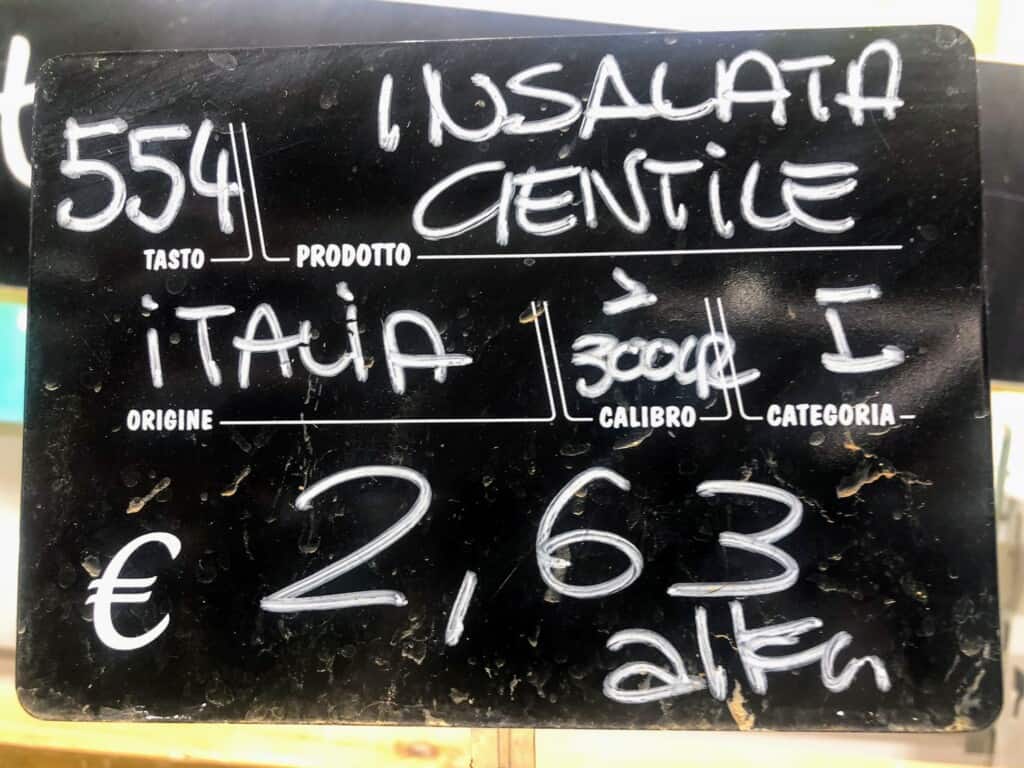
Each produce item has a number called a tasto which is indicated on its price tag (located either above or below the item). Bag the produce and bring it to the electronic scale called bilancia in Italian. Put the produce on the scale, select the number (sometimes you need to punch it in and sometimes there are pictures of the produce with the numbers).
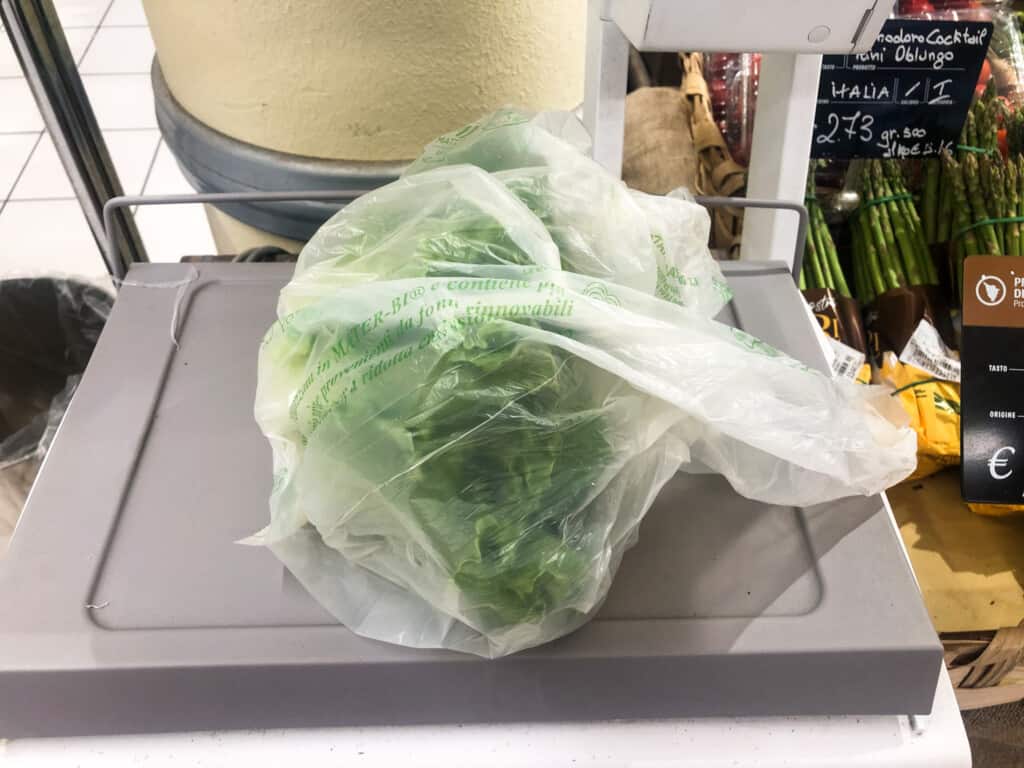
A small sticker will be printed which you can then stick to your bag.
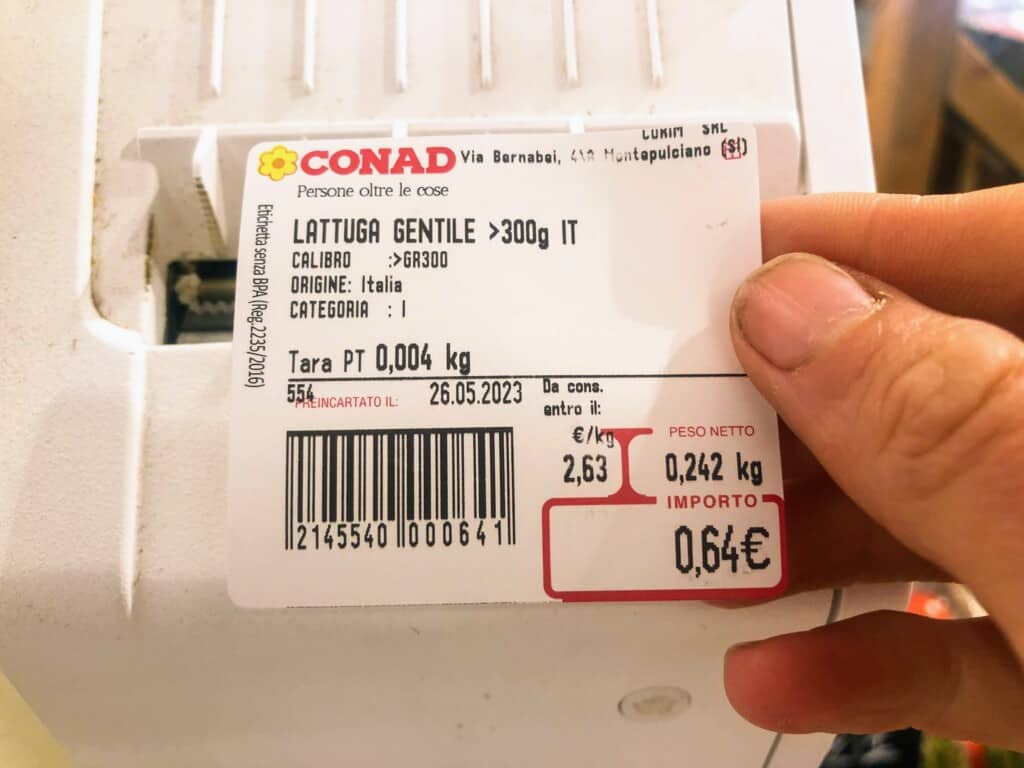
Tip: Always close the plastic bags with a knot because cashiers will just grab them off the conveyor belt and your fruit will go flying out if it’s not closed!
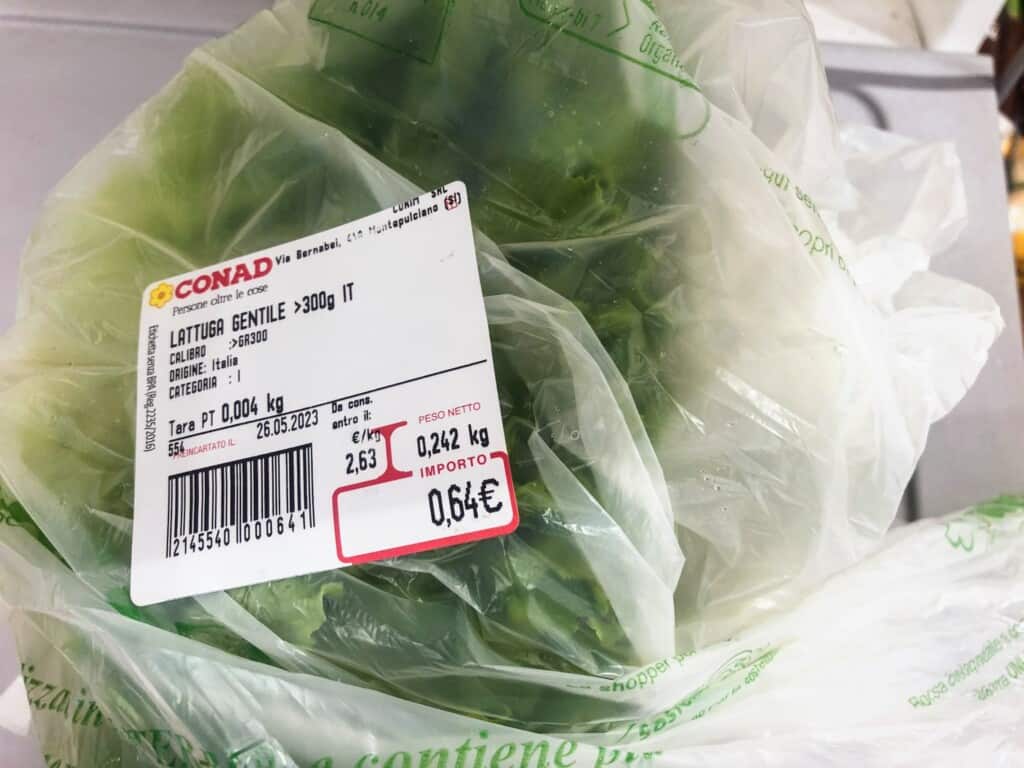
Grocery Bags Are Not Free
If you don’t bring your own grocery bags, you will be expected to pay for plastic ones (no paper bags at Italian grocery stores). They usually cost between €0.05-0.10 each and are very poor quality and often rip or tear.
Tell the cashier you need bags before you pay or you will have to make a separate transaction for two flimsy pieces of plastic!
Good To Know: If you want to purchase a reusable bag, look for them under the conveyor belt as you load your items onto it. They are usually there or somewhere around the checkout counter.
No One Is Going To Bag Your Groceries
You are expected to bag your own groceries in Italy, no matter where you are. Once you have unloaded your items onto the conveyor belt, move past the register and to the end of the check-out counter to start bagging.
Use Your Receipt To Exit The Self-Checkout Area

If you have opted to check out at the self-service line offered at larger grocery stores, hang onto your receipt because you will need to scan it to get out.
Simply put the receipt under the scanner pillar located next to the gate and it will open for you.
Nice To Know: When doing self-check outs, random checks do happen to ensure customers have scanned each item.
Get Your Parking Ticket Stamped

Most grocery parking lots in city centers do have covered or gated lots but you need to get your ticket stamped or scanned before you leave. Just ask the cashier to scan it for you when you checkout.
Good To Know: Parking is usually free for the first two hours but after that, you have to pay.

For Expecting Mothers: Look for parking spots designated for expecting mothers or mothers with small children marked with a pink sign and/or lines.
Italian Supermarkets Aren’t Open 24/7
Italian grocery stores will typically be open from 8:00 am to 8:00 pm Monday-Saturday and either be closed or hold modified hours on Sunday.
Plan Accordingly: Rural areas still enact the after lunch riposo or rest when all shops will close down from about 1:00-3:00/4:00 pm. Where we live in Tuscany the Coop closes from 1:00-5:30 in the summer when it’s too hot to leave the house!
In city centers, most grocery stores will hold some hours on Sunday, typically in the morning from 9:00-1:00. Some ipermercati are open all day but it’s not the norm.
Italian Grocery Stores Often Close On Sundays
There is no general rule for if a grocery store will be open on Sunday or not. You will need to check store hours online for specific locations to be sure.
Good To Know: The Coop is more likely to be closed than other supermarkets such as Essalunga or Conad on Sunday.
No In-Store Grocery Pick-Up
You can not shop online and then pick up your groceries in Italy. Rather, you can shop online and have them delivered to your house (consegna a domicilio) for a small fee (around €7.00-8.00).
You can also opt to shop at some stores, check-out and then have your groceries delivered later that day to your house so you don’t have to lug them up your building with no elevator (this is popular in city centers).
Fact: To use any of these delivery services, you need to be a store club member.
Helpful Things To Know About Italian Grocery Stores
Discounts Are Only For Store Members

Much of what drives supermarket traffic is their deals and bargains but don’t expect to get these discounts if you aren’t enrolled in their membership program.
Getting a tessera or loyalty card is usually free but you need to sign up at the service desk upon entry. If you are just getting a few things, don’t bother waiting in line but if you plan on doing most of your cooking, it’s worth it.
Fact: You do need to pay a one-time fee to be a Coop member. It’s around €25.00, depending on the region.
Self Scanners Are Only For Grocery Store Members

Larger grocery stores have enacted a self-scanning system to speed up check out but you have to have their loyalty card to use one.
If you want to scan your items as you go and self-check out in a matter of seconds, you need to first sign up and get a store membership at the service desk. With this in hand, scan the barcode and your scanner will light up for you to take and start using.
Not All Milk Is Refrigerated

You can either buy normal pasteurized milk that has a relatively short shelf life (about a week to ten days) in the refrigerator section or you can also choose UHT (ultra high temperature) milk that lasts for several months.
The fresh milk is usually on an end cap of the refrigerator section and the UHT milk will be close by, typically in the next aisle over that is not refrigerated with the eggs.
You Cannot Buy In Bulk

Only some items are sold in bulk by weight such as seasonal nuts and some cereals and pet food. Otherwise, you need to buy whole packages, even if you only want a handful of something like dried fruit, spices or coffee.
Water Can Be Purchased As A Case Or Singularly

Most bottles of water come in packages of six in Italian grocery stores. You can either buy the whole case (there may or may not be a discount for this) or you can buy as many or few as you like. Simply rip open the plastic holding them together.
Order Fresh Meats, Cheeses And Prepared Food From The Deli
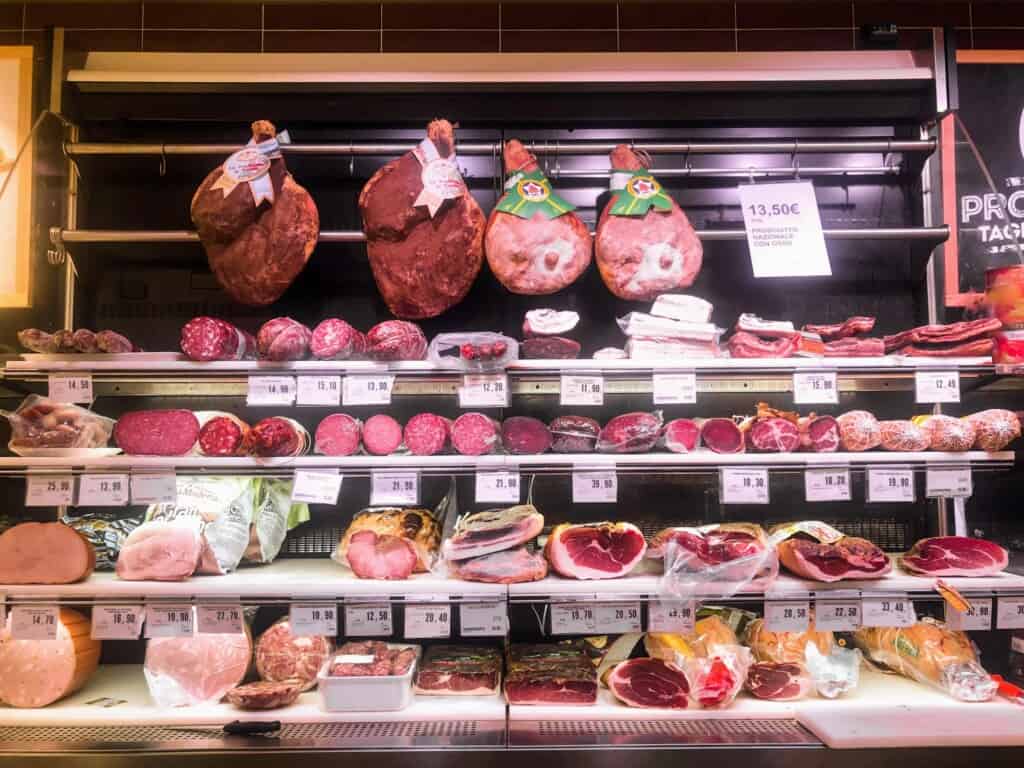
You can either get pre-packaged deli meats and cheeses in the refrigerator section or you can opt to order exactly what you want from the deli. The deli offers high quality items that are always fresh so I suggest doing this.
Get a number from either an electronic machine or a little roll and wait for your turn (don’t leave because they won’t come back to you if they call your number and you didn’t speak up).

You can then ask for exactly what you want in 100 grams quantities or etti (one etto, two etti) as we call them here. For example, if you want ¼ lb of ham you need to order about 100 grams or un etto di prosciutto cotto:
Vorrei un etto di prosciutto cotto, per favore.
I would please like ½ lb sliced ham.
If you are picky about how you like it sliced, specify that as well:
Vorrei due etti di prosciutto crudo tagliato molto fine, per favore.
I would like 200 grams of prosciutto sliced very thinly, please.
You can also ask in quantities by person:
Vorrei mezzo pollo arrosto e patate per due persone, per favore.
I would like half a roast chicken and potatoes for two people, please.

Use this guide when ordering deli items (cheese, meat or prepared food):
| Rough weight in pounds (lbs) | Italian Weight Measurement | Italian Pronunciation | English Translation |
| ¼ lbs | un etto | oon eht-toh | 100 grams |
| ½ lbs | due etti | doo-eh eht-tee | 200 grams |
| ⅔ lbs | tre etti | treh eht-tee | 300 grams |
| 1 lbs | mezzo kilo | mehz-zoh kee-loh | ½ kilogram |
| 2 lbs | nove etti | noh-veh eht-tee | 900 grams |
Tip: If you think the person serving has given you enough, you can stop them by saying:
Va bene così, grazie.
That is fine, thank you.
Be Sure You Can Pay With a Card
Although stores are legally bound to offer an electronic payment option such as a credit card or bank card, many small places still don’t do it (or rather, they don’t like to and so don’t advertise it). Check before shopping at alimentari or small grocers to avoid a problem at the end when you are trying to pay.
Italian Grocery Stores Carry Toiletries

Just like in the US, the grocery store is the most convenient way to buy toiletries. Large grocery stores will also have the largest selection! If you are looking for high-end shampoos, you won’t find them here but run of the mill brands such as Pantene and Fruit Garnier are stocked in almost every single one.
Good To Know: Look for regionally made beauty items such as hand soap, shampoo and creams. Although grocery stores are chains, each region and individual stores are managed differently, stocking locally produced items.
Foreign Products Are Expensive And Limited
Italians like primarily Italian food which is why the international food section is limited. And not only that, it’s super expensive. For example, Italians don’t really like peanut butter (it’s all about Nutella here) so be prepared to pay a premium.
Italian Grocery Stores Can Get Very Crowded
Unless you are at a ipermercato, expect small spaces. The aisles are narrow and the stores tend to wrap around in a funny one-direction kind of way, making it hard to back-track if you miss something.
Plan Ahead: Do your grocery shopping at opening, closing or at lunch (between 1:15-2:30) if you can plan accordingly because it will be much more time efficient. You will most likely enjoy the experience as well, which is harder to do when you are stressed by the sheer crowds of Italians busily shopping away and not paying any mind to anyone but themselves.
Italian Grocery Stores Do Have Bathrooms
Most larger supermarkets will have a restroom you can use. In my personal experience, they are generally on the cleaner side than in places like bars so be sure to use them before you leave! You may or may not have to ask for the key at the service desk.
Helpful Vocabulary For Shopping In Italian Grocery Stores
Keep this table handy when navigating Italian grocery stores. You may need to ask where something is or order a specific item from the deli or meat counter.
| Italian | Pronunciation | English Translation |
| buongiorno/buonasera | bwohn-johr-noh/bwohn-ah-seh-rah | good morning/afternoon |
| arrivaderci | ahr-ree-vah-dehr-chee | good bye |
| per favore | pehr-fah-voh-reh | please |
| grazie | grah-zeeEH | thank you |
| Dov’è… | doh-veh | Where is… |
| Mi Scusi | mee scoo-zee | Excuse me |
| Quanto Costa? | kwahn-toh coh-stah | How much does it cost? |
| Vorrei… | vohr-reh | I would like… |
| tagliato fine/medio | tahl-yah-toh fee-neh/meh-dee-oh | cut thinly/normal |
| macinato | mah-chee-nah-toh | ground |
| mezzo | mehz-zoh | half |
| intero | in-teh-roh | whole |
| busta | boo-stah | bag |
| carta di credito | cahr-ta dee creh-dee-toh | credit card |
| contanti | cohn-tahn-tee | cash |
| spiccioli | speech-choh-lee | change |
| tessera | tehs-seh-rah | store member card |
Numbers In Italian
| Number | Italian | Pronunciation |
| 0 | zero | tzeh-roh |
| 1 | uno | oo-noh |
| 2 | due | doo-eh |
| 3 | tre | treh |
| 4 | quattro | kwaht-troh |
| 5 | cinque | cheen-kweh |
| 6 | sei | say |
| 7 | sette | seht-teh |
| 8 | otto | oht-toh |
| 9 | nove | noh-veh |
| 10 | dieci | dee-eh-chee |
Listen to number pronunciations here:
Items To Buy At Italian Grocery Stores

| Italian Item | English Translation | Notes/Location |
| Olio di Oliva | Olive Oil | Look for regional extra-virgin for the best quality |
| Aceto Balsamico | Balsamic Vinegar | Next to oils |
| Sott’olio | (items) preserved in oil | such as artichokes, olives, sun dried tomatoes, which can be found with the canned goods |
| Sotto aceto | (items) preserved in vinegar | such as vegetables with the canned goods |
| Salumi | Cured meats | ham, prosciutto, etc. either in the deli or prepackaged in the refrigerator section. |
| Pasta all’uovo (asciutta o fresca) | egg pasta (dried or fresh) | refrigerator section or dried pasta aisle |
| Caffè | coffee | several options, usually close to the breakfast items. |
| Vino | wine | Even the smallest of grocery stores in Italy will have a decent wine selection |

What You Can’t Buy In Italian Grocery Stores

Note that you cannot buy medications in Italian grocery stores. For these items, you need to head to pharmacies which can be identified by a green cross outside.
Even if you are looking for something as basic as Tylonal, you can’t get it here. There is usually a pharmacy close by to most supermarkets though so just keep your eyes peeled for the green cross.
Grocery Stores In Italy FAQ
Italy’s most popular grocery stores are:
Coop Italia
Esselunga
Eurospin
Lidl Italia
Carrefour Italia
Despar Italia
The most popular Italian grocery stores are called supermercati:
Carrefour
Conad
Coop
Crai
Despar
Esselunga
Pam
Sigma
The cheapest grocery stores in Italy are the discount stores such as Lidl, Aldi, and Eurospin.
These days you can most likely pay with Apple pay if there is a credit card option. Although shops are legally required to offer this, not all do, especially small mom and pop stores.
Yes, Italy does have bulk stores similar to Costco, but you have to have a business account with them, proving that you can pay with a business credit card. This makes it inaccessible to most visitors.
Yes, Italy is full of various grocery stores of all shapes and sizes. You will find enormous grocery stores with other home departments as well known as ipermercati or regular grocery stores called supermercati.
Grocery delivery is possible in Italy but only in cities. You also need to be a card member to use home delivery services by Italian grocery stores.
You can find supermarkets throughout Italy no matter where you are. In smaller villages in the countryside you may only have one option but it should be well stocked with the basics.
